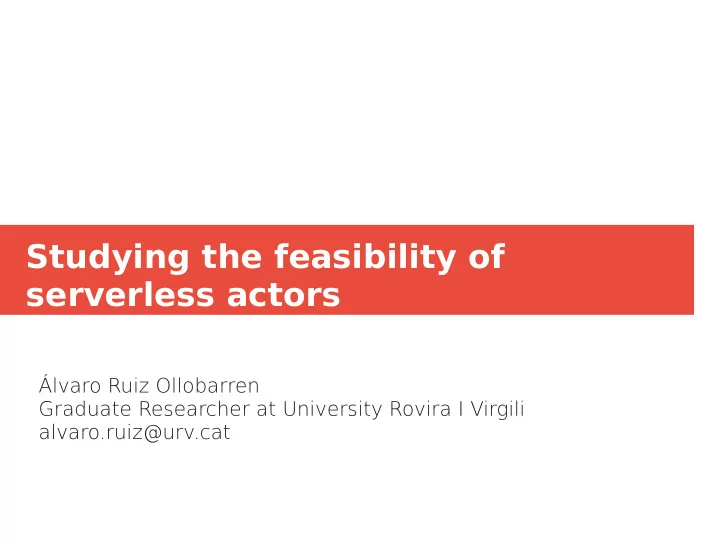

Studying the feasibility of serverless actors Álvaro Ruiz Ollobarren Graduate Reuearcher at Univeruity Rovira I Virgili alvaro.ruiz@urv.cat
Motivation ● Actors are a very popular way of simplifying complex applications. ● Based on stateful single threaded entities ● Popular frameworks: Used in production in [1] : Used in production in [2] : [1] https://www.lightbend.com/case-studies#fjlter:akka 2 [2] http://dotnet.github.io/orleans/Community/Who-Is-Using-Orleans.html
Background ● Not all applications have a straightforward migration to the serverless environment ● Actor model could benefjt from 2 main aspects: ● Billing ● Scalability ● Simplest use case: Counter 3
Challenges ● Addressing: ● Actors need to receive and send messages to other actors. ● Currently FaaS only support invocation requests. usage of external communication services is required. 4
Challenges ● Atomicity: ● T o maintain a consistent state, there cannot be more than one instance of the same actor executing at the same time. ● Serverless functions scale automatically by spawning concurrent containers We need to limit function concurrency 5
Challenges ● State: ● Actors are stateful ● FaaS are stateless: consequent calls to the same function may not maintain previous state External storage services must be used 6
Challenges ● Passivation: ● What to do when no messages arrive? ● Fully event-driven approach: each actor invocation would imply a cloud function request to an external storage ● Keeping the actor running approach: extremely expensive 7
Challenges ● Performance: ● The actor model must be functional, a minimum performance is mandatory . ● This is a special requirement given the high network latencies of the remote components 8
Implementation Architecture overview ● Addressing: SQS ● State: DynamoDB ● Atomicity: confjguration 9
Implementation ● Passivation: ● We propose a hybrid solution: ● Actors process all available messages in a single execution until they don’t receive a message for a while. ● Then, actors load the state into the DynamoDB and fjnish the execution. 10
Implementation ● Passivation: ● This approach requires an event system with two main properties: 1) T o trigger a new execution when the actor’s underlying function has been passivated. 2) When the function is running, notify it without enqueueing more functions invocations. 11
Implementation ● Passivation: ● This behavior requires an external client to: ● Schedule the execution of actors. This client is notifjed when an actor passivates. ● Listen to the passivated actor queue to invoke the actor with the fjrst message received. 12
Related work Azure Durable Functions ● Are created, queried or terminated through HTTP- triggered functions. ● Can orchestrate other functions. ● They also ofger: ● Eternal orchestration functions ● Singleton functions ● Async events 13
Related work Azure Durable Functions ● Are created, queried or terminated through HTTP- triggered functions. Require 2 invocations . ● Can orchestrate other functions. ● They also ofger: ● Eternal orchestration functions. ● Singleton functions. Not atomic ● Async events. Lose events 14
Evaluation Serverless actors vs AWS Lambda ● Serverless actors: ● Each actor’s message will be sent through SQS. ● Then the message will be read by an already running actor, or a new actor invocation will handle the new message. ● Modify a counter variable in the actor local memory . ● FaaS: ● Each message implies a new function invocation ● Make a request to DynamoDB. 15
Evaluation Serverless actors vs AWS Lambda ● Single concurrent lambda ● 3 GB of memory ● Warm containers ● Same invocation process 16
Evaluation Serverless actors vs AWS Lambda ● Up to 5.95 X faster ● Smaller deviation 17
Discussion ● Addressing ● SQS limitations Built-in support for lambda intercommunication ● Passivation ● Events limitations Run time support for functions capable of awakening when messages arrive to a queue, but able to read all available messages from that queue 18
Conclusion ● Serverless actors are possible! ● Our prototype processes up to 5.95× more messages than its FaaS counterpart ● However, we also argue that run-time extensions to the serverless core would be necessary: ● Support for intercommunication ● Event system capable of processing messages effjciently and triggering new functions when necessary Code and tests available at: https://github.com/danielBCN/faasactors 19
Recommend
More recommend